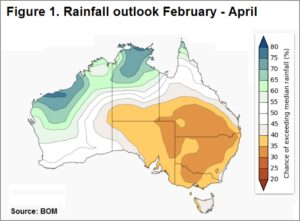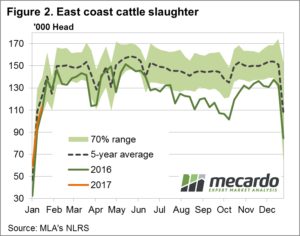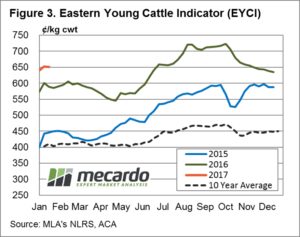Buyers take a pause as dry weather outlook released

The Eastern Young Cattle Indicator (EYCI) was 
marginally softer this week as the Australia Day
holiday and a release from the Bureau of Meteorology
(BOM) showing dryer conditions expected for
February through to April gave buyers reason to pause.
Figure 1 highlights the anticipated rainfall outlook
released from BOM which highlights a reduced
likelihood for rainfall to exceed the seasonal averages
for much of the central and south-eastern region of the
nation. The Bureau is also forecasting a hotter than
average minimum and maximum temperature range
for the same areas of the country anticipated to 
experience the dry spell. The dry and hot forecast
appearing to take some of the “heat” out for the cattle
market this week.
East coast cattle slaughter figures for the week ending
20th January coming in 2.8% higher than for the same
time in 2016 at 112,995 head boosted by Queensland
weekly slaughter figures. Indeed, Queensland was the
only state in the nation to record weekly slaughter
figures above the 2016 levels and above the five-year
average for this time of the year. Despite the boost from
the “Sunshine state” total east coast slaughter is still 
tracking 8.2% below the five-year average trend – figure 2.
Figure 3 outlines this week’s sideways movement in
EYCI closing just 0.75¢ softer at 651.5¢/kg cwt as
restockers pause to think about the weather implications.
This time last year the MLA released an article looking
at the relationship between movements in the EYCI
over January compared the overall performance over
the season. Interestingly they discovered that 78% of
the time the January performance was mirrored in the
rest of the year’s performance.
The week ahead
The MLA article would seem to suggest that based on this
January’s price movements we are in for a positive price
pattern this year, although not as strong price gains as those
that occurred during 2015 and 2016 – figure 3. As we head
into February eyes will be on the skies, temperature gauges
and the condition of the pasture as this will influence how
aggressive restocker demand will be for cattle and if they
will continue to drive the price direction as much as they
did last season.


